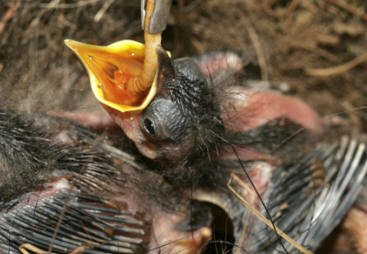Caring for Orphaned and Sick Wildlife
by Dr. Rachel Addleman, DVM, DiplABVP, CVA
Veterinarian and Certified Veterinary Acupuncturist, Dr. Addleman has advanced training and Board Certification in
feline medicine. She practices in Houston, Texas and can be found at
AnimalFixer.com
 Over
the years, many people have brought me orphaned or injured wildlife.
Sometimes they want me to care for it, but many times they want me to
show them how to care for it. I have learned many things about raising
and caring for wild animals, but I always recommend the local wild animal
rescue group take over the care of the animal to give it the best chance
of survival and re-release into the wild. In some cases, state or federal
law mandates a licensed facility. The most panicked phone calls come
from someone who has just mowed over a bunny nest in their yard. A mother
rabbit is called a doe, and they often burrow a nest in plain sight,
not uncommonly in the middle of the yard. A baby bunny is called a kit,
and a nest of them are called kittens.
Over
the years, many people have brought me orphaned or injured wildlife.
Sometimes they want me to care for it, but many times they want me to
show them how to care for it. I have learned many things about raising
and caring for wild animals, but I always recommend the local wild animal
rescue group take over the care of the animal to give it the best chance
of survival and re-release into the wild. In some cases, state or federal
law mandates a licensed facility. The most panicked phone calls come
from someone who has just mowed over a bunny nest in their yard. A mother
rabbit is called a doe, and they often burrow a nest in plain sight,
not uncommonly in the middle of the yard. A baby bunny is called a kit,
and a nest of them are called kittens.
Always the concern is that the mother rabbit is nowhere in sight. Mother
rabbits generally only feed the babies once during the night or for
a few minutes in the early morning. That would be the only time you
will see the mother, so don’t assume the mother has abandoned her nest.
If you’re not sure, you can place some leaves or string over the nest
to see if the mother has returned overnight.
If the mother has not returned in 24 hours, and when you feel the babies
they are cold, you may need to bring them to the rescue group. Mother
rabbits will not abandon a nest if you minimally handle the babies.
Rabbits have a good sense of smell and are used to humans in their environment.
Young wild bunnies generally leave the nest when they are about five
inches long. If your children (or cat) have brought one like this home
and it is uninjured, its mother is likely nearby and it can probably
live on its own. You may need to keep your cats and children safely
away, so the bunny doesn’t lose its natural fears.
At a little over six inches the baby holds its ears erect and doesn’t
need to be rescued, even though it looks fragile and small.
 Another
frequent encounter with wildlife is an orphaned baby bird. Songbirds
are frequently found out of their nest. My building manager brought
me two little featherless baby birds she found on the ground outside
my office just last week.
Another
frequent encounter with wildlife is an orphaned baby bird. Songbirds
are frequently found out of their nest. My building manager brought
me two little featherless baby birds she found on the ground outside
my office just last week.
Featherless baby birds found on the ground can be placed back into the
nest, if you can find it. That is probably their best chance at making
it. If you cannot find the nest, keep them warm until you can bring
them to the wildlife rescue group.
A baby bird with feathers on the ground is called a fledgling, and is
usually being fed by its mother. It takes time and practice to learn
to fly. Some species of birds spend hours every day on the ground, and
fledglings may take many days to learn to fly. If the fledgling is in
danger of traffic or animals, you can move it to a shrub. If you have
a hard time catching it to move it, this bird does not need your help
at all!
With an injured animal, place a towel over it to catch it. Keep it in
a warm area until you can bring it to the wildlife rehabilitators.
As for the two little birds found outside my office, they were put safely
back in their own nest. I hope they stay around my office so I can enjoy
their song when they grow up
